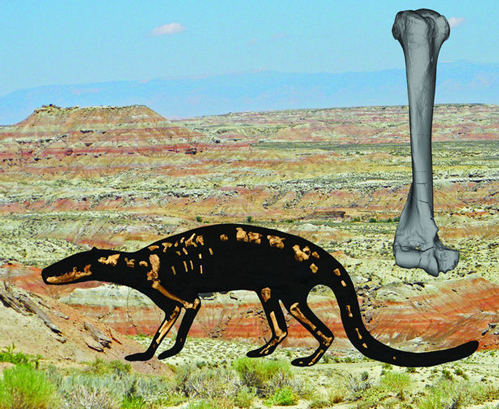Remarkable Wyoming Fossil Find Helps to Explain Mammalian Carnivore Evolution
“Polecat Dogs” Galecyon mordax et al and Mammalian Carnivore Evolution
As 2015 draws to a close, after all, this time next week it will be 2016, team members at Everything Dinosaur have been reviewing a paper published in the most recent issue of the “Journal of Vertebrate Palaeontology” (we can’t bring ourselves to use the “Americanised” spelling), entitled: “The postcranial skeleton of Galecyon: evidence for morphological and locomotor diversity in early Hyaenodontidae (Mammalia, Hyaenodontida)”.
An Early Eocene Carnivore
Exactly one hundred years ago the fossil bones of an Early Eocene carnivorous mammal were scientifically described. The fossils, including skull bones, jaw fragments and teeth were between 55 million and 50 million years of age and demonstrated an early radiation of the Mammalia towards larger predators after the demise of the Dinosauria.
Subsequently the fossil bones were assigned to the genus Galecyon and a number of species have been erected for example, Galecyon mordax (the name translates from the Latin as “biting polecat dog”- we think).
In this newly published paper, scientists from the University of Arizona in collaboration with colleagues from The Johns Hopkins University (Baltimore, Maryland) were able to pull together a number of Galecyon fossil finds, including limb bones and from this study they have concluded that this fox-sized hunter was on the way to becoming a fully terrestrial carnivore.
An Artist’s Rendition of the Ancient Carnivore

An artist’s rendition of the shape of Galecyon, with its fossilised bones laid out anatomically. Background shows fossil formation, right humerus (inset).
Picture credit: Journal of Vertebrate Palaeontology
Galecyon mordax
The picture above shows a silhouette of the Early Eocene carnivore with the fossil bones used in the study placed in the correct anatomical position. The Willwood Formation of Wyoming (southern Bighorn Basin), the location where the majority of the Galecyon material come, from is shown in the background. The enlarged bone featured is the right humerus (upper arm bone). From the subsequent analysis of the limb bones, the researchers were able to deduce that Galecyon was better adapted to a cursorial, terrestrial existence than its contemporaries which showed anatomical adaptations more akin to a climbing (scansorial) habit.
On the Road to the Carnivora
Prior to the evolution of the mammalian order Carnivora (the carnivores), which includes cats, dogs, seals, walruses, bears and raccoons, North America was dominated by group of primitive meat-eating mammals called hyaenodontids. This group of placental mammals, in turn, have their origins in the Palaeocene Epoch. Fossils, particularly teeth are relative common in Wyoming but other material, especially postcranial material is exceptionally rare. Using a recently discovered more complete specimen and other referred material, the authors were able to piece together a better idea of how Galecyon moved. This helps to provide a better understanding of how the hyaenodontids were evolving.
Lead author of the study, Dr Shawn Zack (University of Arizona) explained:
“The skeleton of Galecyon shows why we keep looking for fossils even in places where we already have a lot of specimens. When this skeleton was found, tens of thousands of mammalian fossils had been collected from the Bighorn Basin, but this was the first decent skeleton of this animal.”
Wyoming Fossil
Weighing between five and seven kilogrammes, Galecyon was only about the size of a European Red Fox (Vulpes vulpes) and the fossil limb bones show that it was not entirely scansorial (tree climbing), like some of its hyaenodontid Early Eocene contemporaries. Nor was it a fast runner like some of the later hyaenodontids such as those genera that flourished in the Oligocene. However, the team were able to infer locomotory abilities and show progression towards a more agile, pursuit predator existence. For Galecyon itself, this new research suggests it was the Early Eocene equivalent of a skunk or a wolverine.
Helping to Build up the Hyaenodontid Family Tree
The postcranial material also allowed the researchers to explore the evolutionary relationships between different hyaenodontids. Teeth are the most common parts of the skeleton found, so dental characteristics can be investigated, but the new specimen allows for other additional parts of the skeleton to be studied too.
Commenting on the significance of this study, Dr Zack stated:
“This study shows that postcranial and dental morphology support different patterns of hyaenodontid relationships. That is an indication that there is still a lot to learn about hyaenodontid evolution. In addition, this study shows that early hyaenodontids had diverse habitat preferences, which helps explain how several different hyaenodontids were able to co-exist in the same faunas, despite having similar diets and comparable body sizes.”
Everything Dinosaur stocks a range of prehistoric animal models including several replicas of Cenozoic carnivores: Models of Prehistoric Mammals.

